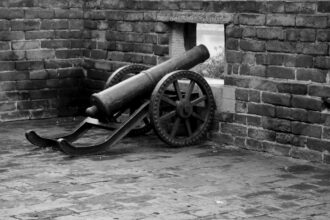Operation Eagle Claw, the ill-fated mission to rescue American hostages held in Iran, emerged from a complex backdrop of geopolitical tensions and domestic turmoil. In November 1979, a group of Iranian students stormed the U.S. Embassy in Tehran, taking 52 American diplomats and citizens hostage.
This act was fueled by widespread anti-American sentiment, stemming from the U.S. support of the Shah of Iran, who had been overthrown earlier that year. The hostage crisis quickly escalated into a significant diplomatic incident, capturing the attention of the American public and government alike.
As the days turned into months, the urgency to resolve the situation grew, leading to the planning of a military rescue operation. The hostage crisis not only strained U.S.-Iran relations but also highlighted the vulnerabilities of American foreign policy in the Middle East. The Iranian Revolution had transformed a key ally into a hostile adversary, and the inability to secure the release of the hostages became a source of national humiliation for the United States.
President Jimmy Carter’s administration faced mounting pressure to act decisively, as public frustration with the prolonged crisis intensified. This environment set the stage for Operation Eagle Claw, which aimed to demonstrate American resolve and military capability in the face of international challenges.
Key Takeaways
- Operation Eagle Claw was a failed rescue mission by the US to free American hostages in Iran in 1980.
- The planning and preparation for the mission were rushed and lacked coordination among the military branches.
- The execution of Operation Eagle Claw was marred by equipment failures and a helicopter crash in the Iranian desert.
- Unforeseen challenges and obstacles, such as a sandstorm and mechanical issues, contributed to the mission’s failure.
- The failed rescue attempt led to the deaths of eight American servicemen and further strained US-Iran relations.
Planning and Preparation for the Mission
The planning phase for Operation Eagle Claw was marked by urgency and complexity. The mission was conceived as a multi-faceted operation involving various branches of the U.S. military, including Delta Force, the Navy SEALs, and Air Force units.
The objective was to infiltrate Iran, rescue the hostages from the embassy compound, and safely extract them back to American soil. The operation required meticulous coordination and extensive intelligence gathering to ensure success. However, the lack of reliable information about the hostages’ exact location and the security measures in place at the embassy posed significant challenges.
In preparation for the mission, extensive training exercises were conducted to simulate various scenarios that could arise during the operation. Special forces units practiced infiltration techniques, hostage rescue protocols, and extraction procedures under conditions that mirrored those expected in Iran. Despite these efforts, time constraints and logistical difficulties hampered thorough preparation.
The mission was further complicated by political considerations, as officials grappled with the implications of a military intervention in a volatile region. As the date for the operation approached, tensions ran high, and doubts about its feasibility began to surface.
Execution of Operation Eagle Claw

On April 24, 1980, Operation Eagle Claw was set into motion. The plan involved deploying a fleet of aircraft to transport troops and equipment to a staging area in Iran’s desert region. From there, special forces would move toward Tehran to execute the rescue operation.
However, as the mission commenced, it quickly became apparent that unforeseen complications would plague its execution. Weather conditions were less than ideal, with sandstorms reducing visibility and hampering navigation for the aircraft involved in the operation. As the helicopters arrived at the designated rendezvous point, they encountered additional difficulties.
Mechanical failures and communication breakdowns further complicated matters, leading to delays that jeopardized the entire mission. Despite these setbacks, some units pressed on with their objectives, determined to fulfill their orders. However, as they moved deeper into Iranian territory, it became increasingly clear that the operation was unraveling.
The initial plan had relied on precise timing and coordination; without these elements, chaos ensued.
Unforeseen Challenges and Obstacles
| Challenges | Obstacles | Solutions |
|---|---|---|
| Supply chain disruptions | Shortage of raw materials | Seek alternative suppliers |
| Technical issues | Equipment breakdown | Regular maintenance and backup systems |
| Market volatility | Fluctuating demand | Diversify product offerings |
The challenges faced during Operation Eagle Claw were numerous and varied. One of the most significant obstacles was the mechanical failure of several helicopters involved in the mission. As they attempted to navigate through hostile territory, one helicopter experienced a critical malfunction that forced it to land prematurely.
This incident not only compromised the safety of the troops on board but also raised alarms about their presence in Iran. The loss of this helicopter was a pivotal moment that signaled trouble ahead for the operation. Additionally, communication issues plagued the mission from its inception.
The complexity of coordinating multiple units across different branches of the military created an environment ripe for miscommunication. As troops attempted to regroup after encountering mechanical failures and adverse weather conditions, confusion reigned supreme. The lack of clear communication channels hindered their ability to adapt to changing circumstances on the ground, ultimately leading to further disarray as they sought to execute their objectives.
The Failed Rescue Attempt
As Operation Eagle Claw progressed, it became increasingly evident that success was slipping away from the grasp of American forces. The combination of mechanical failures, adverse weather conditions, and communication breakdowns culminated in a disastrous outcome. After several hours of attempting to regroup and reassess their strategy, commanders made the difficult decision to abort the mission.
The realization that they could not safely extract the hostages led to a somber retreat from Iranian territory. The failed rescue attempt marked a significant turning point in U.S. military history.
It not only underscored the limitations of military intervention in complex geopolitical situations but also highlighted the importance of thorough planning and preparation. The operation’s failure resulted in a loss of credibility for the U.S. government and military leadership at a time when public confidence was already waning due to ongoing domestic challenges.
Aftermath of Operation Eagle Claw

In the wake of Operation Eagle Claw’s failure, both American officials and citizens grappled with feelings of disappointment and frustration. The inability to rescue the hostages not only deepened national humiliation but also raised questions about U.S. military capabilities and decision-making processes.
The aftermath also saw a reevaluation of U.S. foreign policy in Iran and broader Middle Eastern contexts. The failed mission prompted discussions about intelligence gathering, military readiness, and diplomatic strategies moving forward. In many ways, Operation Eagle Claw served as a catalyst for change within military operations and foreign policy approaches in subsequent years.
Criticisms and Controversies Surrounding the Mission
Operation Eagle Claw was not without its share of criticisms and controversies. Many observers questioned whether sufficient intelligence had been gathered prior to launching such a high-stakes military operation. Critics argued that reliance on outdated or incomplete information contributed significantly to its failure.
Additionally, some military analysts contended that there was an overestimation of American capabilities in executing such complex missions without adequate preparation. Furthermore, there were concerns regarding inter-agency coordination among various branches of government and military leadership during planning stages. The lack of unified command structure led to confusion and inefficiencies that ultimately hindered operational success.
These criticisms sparked debates about accountability within military ranks and raised questions about how future missions could be better organized to avoid similar pitfalls.
Impact on US-Iran Relations
The fallout from Operation Eagle Claw had lasting implications for U.S.-Iran relations that extended far beyond 1980. The failed rescue attempt solidified animosity between both nations and deepened mistrust on both sides. For Iran, it served as a rallying point against perceived American imperialism and interventionism in their affairs.
The hostage crisis continued for 444 days after Operation Eagle Claw’s failure before finally concluding with negotiations that resulted in their release. In subsequent years, U.S.-Iran relations remained fraught with tension as both countries navigated a complex geopolitical landscape marked by mutual suspicion and hostility. The legacy of Operation Eagle Claw loomed large over diplomatic efforts between Washington and Tehran, shaping perceptions and policies for decades to come.
Lessons Learned from the Failed Mission
Operation Eagle Claw provided several critical lessons for military strategists and policymakers alike.
The failure to obtain accurate information about hostages’ locations and security measures significantly hampered operational success and underscored how vital intelligence is in modern warfare.
Additionally, inter-agency coordination emerged as another crucial lesson learned from this experience. Ensuring seamless communication between various branches of government and military units is essential for effective planning and execution during complex operations. Future missions would benefit from adopting more integrated approaches that prioritize collaboration among all stakeholders involved.
Legacy of Operation Eagle Claw
The legacy of Operation Eagle Claw is multifaceted; it serves as both a cautionary tale about military intervention in foreign crises and an example of resilience in facing adversity. While it ultimately failed in its primary objective—rescuing hostages—it prompted significant changes within U.S. military strategy regarding special operations missions moving forward.
Moreover, it highlighted vulnerabilities within American foreign policy frameworks that necessitated reevaluation in light of evolving global dynamics post-1979. As such, Operation Eagle Claw remains an enduring reference point for discussions surrounding military ethics, strategic planning, and international relations.
The Significance of Operation Eagle Claw in Military History
In terms of military history significance, Operation Eagle Claw stands out as a pivotal moment that reshaped perceptions about U.S. military capabilities during crises abroad. Its failure underscored limitations inherent within conventional approaches to hostage rescue operations while simultaneously prompting innovations in special operations tactics over subsequent decades.
Furthermore, it served as an early example illustrating how complex geopolitical landscapes can complicate even well-planned missions—an insight that continues to resonate with contemporary military strategists today as they navigate increasingly intricate global challenges. In conclusion, Operation Eagle Claw remains an important chapter in both American history and military strategy discourse—a reminder that even with meticulous planning and preparation, unforeseen challenges can derail even the most well-intentioned missions when navigating complex international landscapes fraught with tension and uncertainty.
The failure of Operation Eagle Claw, a U.S. military mission intended to rescue hostages in Iran in 1980, remains a significant event in military history, highlighting the complexities and challenges of executing such high-stakes operations. For those interested in exploring similar military endeavors and their outcomes, an insightful article can be found on the War Room website. This article delves into various military operations and the lessons learned from them, providing a broader context to understand the intricacies of military strategy and execution. You can read more about these topics by visiting this article.
WATCH THIS! From Tehran to Blackwater: The Real Story
FAQs
What was Operation Eagle Claw?
Operation Eagle Claw was a United States military operation aimed at rescuing 52 American hostages held in the U.S. Embassy in Tehran, Iran, during the Iran hostage crisis in 1980.
What was the outcome of Operation Eagle Claw?
Operation Eagle Claw ended in failure when a number of unforeseen complications, including a sandstorm and mechanical failures, led to the mission being aborted. During the operation, a number of U.S. military personnel were killed and several aircraft were destroyed.
What were the consequences of the failure of Operation Eagle Claw?
The failure of Operation Eagle Claw was a significant blow to the prestige of the United States military and government. It also had a lasting impact on U.S.-Iran relations and the handling of hostage situations.
How did the failure of Operation Eagle Claw impact future military operations?
The failure of Operation Eagle Claw led to a reevaluation of U.S. military capabilities and the development of new special operations units, such as the U.S. Army’s Delta Force. It also highlighted the need for better coordination and planning in future military operations.




